Blip.tv, or Blip Networks, Inc., was an American online video hosting site founded on May 5, 2005, by five co-founders Mike Hudack, Dina Kaplan, Justin Day, Jared Klett, and Charles Hope. It was located in New York City (headquarters) and Los Angeles.
Started off initially as a place for free video blogging, podcasting and video sharing, Blip.tv soon grew into the destination with a large collection of original web series. Seeking high-quality content, it welcomed independent producers and budding content creators, and helped them in distributing and monetizing the content, across multiple platforms.
Hosting a wide range of comedies, dramas, sports, food, video games, fashion and other series, Blip.tv syndicated the content to iTunes, YouTube, Facebook, Roku and many other channels. It also launched Blip Studios in an attempt to brand its production sector.

In 2013, Blip was acquired by Maker Studios, and the latter shut down Blip on August 20, 2015. Today if you try to visit the website of Blip.tv, it will redirect you to the site of Maker Studios: www.maker.tv which is also inactive now. Maker Studios was bought by The Walt Disney Company in 2014, and was later absorbed into Disney Digital Network in 2017.
The History of Blip.tv
The idea to create Blip.tv came about when Hudack, Kaplan and other co-founders were active in Yahoo's video blogging group in 2005. When sharing insights and ideas within the group, they saw an opportunity to create a video hosting platform for independent creators, a site that can provide "a great service for great shows".
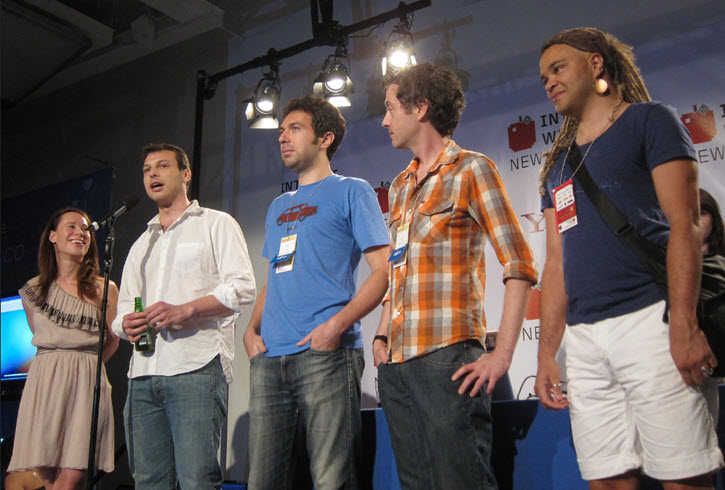
Being aware of the fundamental changes when it was much easier for individuals and small groups to create quality content, the blip.tv team told zdnet their initial mission was to better support budding producers and video bloggers, by taking care of servers, tools, distribution, and monetization.
The idea soon transformed into a business. The team purchased the blip.tv domain, and went online with Hudack's IT expertise, the team's servers, and funding from angel investors.
In 2005 the company garnered $500,000 in seed funding, followed by capital from Ambient Sound Investments in 2007. Blip.tv also received backing from Canaan Partners and Bain Capital Ventures, enabling it to expand its operations and services.
The year 2008 also witnessed a significant number of Revver users moving to Blip, following a contentious situation of the former. The large-scale migration happened shortly after Revver was sold to LiveUniverse, with the latter abandoning the revenue-sharing model, resulting in a revenue decline for content creators.
Blip.tv Entered a Period of Rapid Growth
Blip.tv was carving out a name for itself in a competitive market during its early years, and the early 2010s saw its rapid growth. In September 2008, the company claimed to have served more than 51 million video views, a 250% increase compared to the previous year.
In February 2010, Blip network announced that it had scored 85 million video views, both from hosting and distributed shows, signifying nearly doubled views year-on-year. Among these views, the company also reported that 85.47% of them were qualified for advertising from major brands, which also doubled the year-ago statistics.
Blip.tv worked closely with advertisers such as AT&T, Chevrolet, MetroPCS, PepsiCo, Samsung, Scion and Starbucks. The team also ran campaigns with Best Buy, Canon, Chilis, the Las Vegas Board of Tourism, Nikon, Puma, Starburst, TJ Maxx, and Warner.
In May 2010, Blip.tv claimed to have attracted more than 90 million video views a month, which is an increase from 85 million views reported in February. The platform welcomed more than 44,000 active independent show producers who managed their shows, uploaded new episodes, and interact with their viewers in the community.
Blip.tv raised significant amounts of funding to support its growth. As disclosed by Mike Hudack during his keynote at Vator Splash NY, the company raised an initial $500,000 in seed funding back in 2005.
In June 2007, Blip.tv secured $5.2 million in funding from Ambient Sound Investments, followed by $10 million, a series C funding round led by Canaan Partners and Bain Capital Ventures, which was closed in 2010.
During this period, the distribution network of Blip.tv grew significantly. It partnered with AOL Video, iTunes, YouTube, Facebook, Vimeo, TiVO, Verizon FiOS, the Roku Digital Video Player and Sony Bravia, in form of video hosting or syndication.
Role Changing: From Video Distribution to Video Destination
If the late 2000s witnessed Blip.tv as a tech platform for distributing streaming videos, starting from 2012, Blip gradually shifted its focus in an effort to become a video destination, or the digital portal with millions of viewers worldwide as claimed by the company.
Echoing the policy to reposition itself as the go-to destination for web series, Blip.tv underwent a massive redesign, bringing the most popular episodic web series and shows front and center. The new logo and name are rolled out, with .tv dropped and the platform is now "Blip".
According to Tubefilter, the platform worked with Maslansky Luntz to pinpoint the needs of online video viewers, identifying their wants and entertainment preferences. The team conducted surveys and asked how people discover content. The findings are people need better ways to discover high-quality content, instead of being spoon-fed whatever the site has to offer.
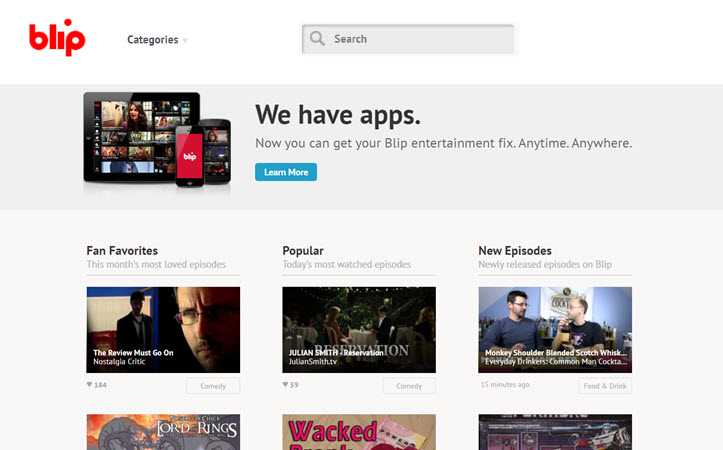
The revamped site strived to be an "intuitive and easily navigable video destination", so that more viewers can leverage Blip's high quality content. The re-design was proved positive in video views, which surged by 131% in March 2011, despite the 11% decrease in Blip's unique visitors.
As of 2013, Blip TV had been offering one of the largest catalogs of original web series online, and it was still under its way to creating comprehensive advertising opportunities for brands in all consumer categories.
Major Internal Reorganization
Along with the brand re-positioning and massive overhaul of its website design, the company was going through signification internal reorganization.
Mike Hudack, Blip's CEO and one of its five co-founders, had been taking indefinite leave since mid-October 2011 for medical reasons. He then joined Facebook as a product manager in 2012.
Charles Hope left the company in early September 2011. Dina Kaplan, another of the original five co-founders, was transitioning on from the company and heading for a new project.
At the end of November 2011, CTO Justin Day and Chief Engineer Jared Klett were the remaining two co-founders of Blip.tv.
Blip appointed Kelly Day as the company's new CEO in 2012, acknowledging her expertise and experience in establishing strong distribution partnerships and growing audiences. Before joining Blip, Kelly Day was the EVP and General Manager at Digital Media and Commerce of Discovery Communications. Jeffrey Glass, a member of Blip Board, claimed that Day's experience was perfectly in line with Blip's overall vision - helping content producers to better distribute and monetize their content extensively.

Joining Kelly Day was Max Smith – previously the Chief Financial Officer of Talking Media Group - was the new CFO for Blip. Plus, the new President of Sales and Marketing was Jason Krebs, who formerly worked at Tremor Video as the Chief Media Officer.
Blip Studios: The Entrance into the Production Game
In 2012, shortly after Kelly Day joined Blip, the platform announced the launch of Blip Studios, which signifies the company's entrance into the production game.
Kelly Day envisioned Blip Studios as a real consumer brand for original Web television and a TV network for digital platforms. In setting up Blip Studios as the virtual production company, Kelly Day believed that it can provide "something special, something exclusive for the audience" as a brand.
Blip Studios was headed by Steve Woolf, who worked closely with ads providers, talent and independent producers. Woolf considered Blip Studios as a way to "push the boundaries of audience interactivity" and an ultimate goal to create "innovative content that leads storytelling into the next decade".
During its heyday, Blip Studios has signed exclusive agreements with many flourishing independent production companies for their talent and shows. For instance, there were hit series such as Nostalgia Critic, Nostalgia Chick, and Todd in the Shadows.
In 2013, the content from Blip Studios had scored more than 250 million views cumulatively.
Seeking Out More Partnerships and Opportunities
Under the leadership of Kelly Day and echoing the ultimate goal of Blip Studios, the company explored ways for sustainability and growth.
Some notable cooperations during this period are the launching of The Guantlet and Blip's cross promotion with Yahoo Screens, where the two companies were featuring dozens of shows from each other.
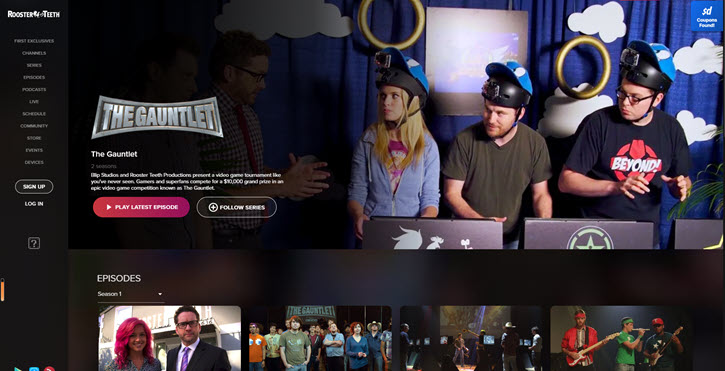
The Guantlet was the platform's attempt to create other models of relationship with audiences, besides the on-demand web series streaming. Partnered with Rooster Teeth Productions, The Guantlet is a video-game competition series, aired real-time in 2012. It proved that creating a super-passion fan base for the scheduled event can be utilized in an advertising supported model.
As for the partnership with Yahoo, each company was entitled to a share of the advertising revenues earned from their videos featured on each other's site.
The same year in 2012, Blip.tv signed deals with phenomenon YouTube creators: DIY talent Kipkay sketch, comic guru Julian Smith, and z-film expert The Cinema Snob for distribution and sales.
Blip Studios held exclusive contracts for talent and distribution with Channel Awesome – which stayed with Blip for the remaining years till Blip's demise, Juliansmith.tv, My Damn Channel, and other entities in 2013.
Another notable partnership was with FremantleMedia, which breaks up with YouTube, and moved the ad-sales partnership with Blip Network in 2013. FremantleMedia was best known for its American Idol series, and the cooperation with Blip was for the online channel The Pet Collective. The MCN claimed that there was a better revenue-sharing model with Blip against the 45-55 terms with YouTube.
Blip Was Acquired by Maker Studios
The seemingly flourishing expansion quickly went to a halt when Blip.tv was acquired by Maker Studios on August 21, 2013.
According to Variety, the Blip's executive team was included with the purchase, with the CEO Kelly Day becoming an advisor for Maker Studios, Max Smith being Maker's CFO, Jason Krebs leading the sales efforts and Jeff O'Connel joining as a senior VP of technology.
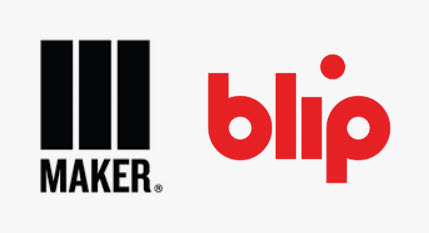
Ynon Kreiz, executive chairman of Maker Studios, claimed the acquisition is beneficial to Maker studio in terms of Blip's distribution technology and content partnerships. Besides Blip's cooperation with YouTube, AOL and other online sites, Maker Studios was also interested in tapping the potential resources of iOS, Android, Xbox, Roku, and Kinlde via Blip's apps.
What Then Happened to Blip.tv
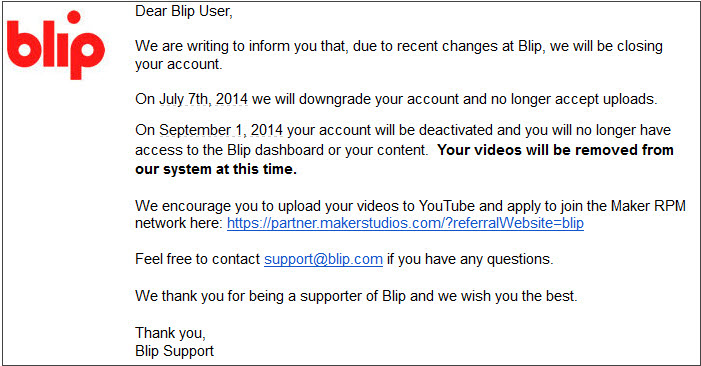
Things went downhill after the acquisition. In May 2014, many Blip users were notified via email that they were no longer entitled to upload content to Blip after July, and that their channels would be terminated the following September.
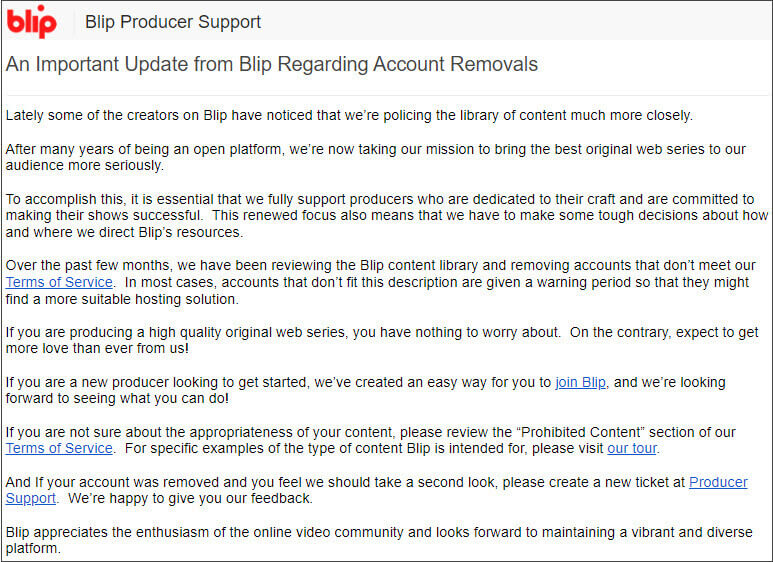
In the notification regarding Account Removals, Blip Producer Support explained the transition from an open platform to a more focused one with the best original web series, suggesting that the platform will remove accounts that don't meet their Terms of Service.
On August 20, 2015, Blip was shut down by Maker Studios. The latter encouraged existing creators to shift to Maker Gen network.
Running Against the Time: The Archiving Team's Effort
The Web Archive Team encouraged users to help with the archiving project for Blip.tv. On a dedicated wiki page, they listed out methods to run the Archive Team Warrior tool to salvage the content before everyone loses access to blip.tv forever.
Today, you can still access partial of Blip's content via the Web Archive. There are over 100,000 videos, with a size of 25.2 TB stored on the Web Archive's website.
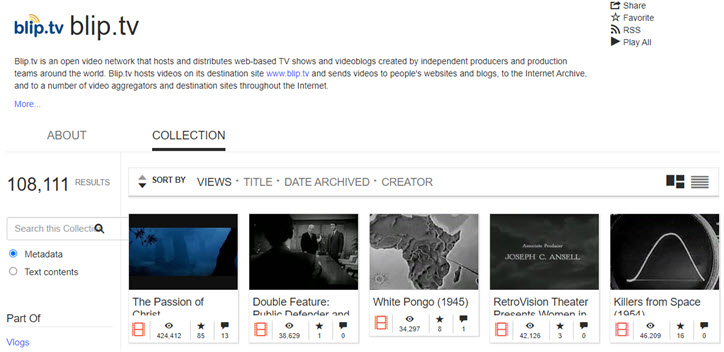
Thanks to the effort of the Archive Team, people now still have access to some videos saved in the two rounds.
Videos saved in the first round: https://archive.org/details/bliptv
Videos saved in the second round: https://archive.org/details/archiveteam_blip
There is also a searchable index for links to Blip.tv videos: https://thazman.github.io/thazman/Bloop.html







